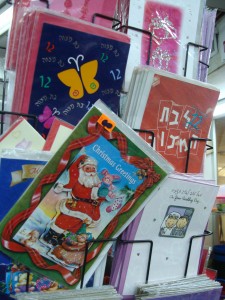
The Jerusalem Post, December 25, 2009
Zara’s display of a Christmas tree sparked controversy and anger throughout Israel last week. Following complaints from the public, the Spain-based fashion chain changed their window decorations, removing symbols associated with the Christian holiday and, in some places, adding candlesticks to mark the local holiday.
A post-chanukah stop at Tel Aviv’s Dizengoff Center found Zara’s windows empty of any winter cheer. But Christmas decorations were still about—HaKol Beh $, the dollar store on the ground floor, had a modest stock of Santa-decorated school folders, greeting cards, and bits of plastic greenery reminiscent of Christmas tree trimmings.
Pointing to the faux branches, owner Rachel Tzioni says, “I add them to my hannukiah. It’s pretty.”
In the past, such decorations were purchased mainly by foreign workers and Russian immigrants, Tzioni says. But in recent years, Tzioni has observed that a growing number of Jewish Israelis are stopping by her store to pick up a little bit of red and green for their home.
“It’s not our holiday,” she says. “But it’s another reason to party.”
For some, the occasion and its trimmings inspire less enthusiasm. In Shine, a tragically hip café on Frishman Street, a tiny Christmas tree greets patrons. Its plastic branches are powdered with fake snow and studded with a handful of red and silver ornaments; it’s capped by a white star, crooked, like it was placed in a hurry.
The coffee-sipping Tel Avivians don’t seem to notice the tree. Giving it a bored glance, a waitress simply remarks, “It’s just something decorative.”
At Shuk HaCarmel, both the customers and salesmen are more spirited—but, according to Shlomo Maoz, the sales haven’t been this year.
Maoz runs a stall that stocks toys, small household goods and decorative items. In December, the front of his store is flanked with white and green plastic trees and blue, silver, and white tinsel dangle from the entryway. He sells these items mostly to migrant laborers and Russian immigrants, he says. When asked about this winter’s business, he shakes his head and remarks that he’s not seeing as many foreign workers as he used to. Perhaps the slump in sales is related to the Israeli government’s recent crackdown on illegal residents, enforced by the Oz Unit.
Maoz offers a simpler explanation. “Maybe they [foreign workers] are buying at the Tachana Merkazit,” he says.
And there’s a lot to choose from at the Central Bus Station. Tables are trimmed with a rainbow of tinsel. Boxes and baskets display delicate glass ornaments—jewel-colored globes of red, green, and gold. Inflatable Santa Clauses and snowmen stand near a forest of fake pines.
Two Indian women, Christian—like some 2 percent of their countrymen—stop and stand in front of a larger-than-life Santa. They laugh as they take pictures of each other in front of it, then move on to take pictures amongst the cluster of plastic trees. Nearby, two Filipinas do the same, using a smiling snowman as the backdrop.
A pair of dreadlocked Israelis mill about. Curious, they run their fingers over the tips of the trees and look at the price tags.
The majority of the customers and staff of these stalls are immigrants from the Former Soviet Union. But their winter celebration, which is held on the New Year, shouldn’t be confused with Christmas, manager Alexander Zelentsov says.
“In Russia, it’s the biggest holiday of the year,” Zelentsov remarks, explaining that it’s the only national holiday free of politics or history. It is also a completely secular occasion, he adds.
“From the outside, it looks like Christmas, but there is no connection. And there is no symbol of Christ.”
Zelentsov also explains that the inclusion of the Santa-Claus-like figure isn’t related to the Christian Saint Nicholas. Pointing to a paunchy figurine, he says, “This is Grandfather Frost.”
“But because this all looks like Christmas, it makes problems,” Zelentsov adds. As if to make Zelentsov’s point, two young Israeli men with long hair and blue and white kippot walk by, and comment loudly on the Russian celebration of “Christmas.”
Zelentsov, who has been in Israel for over a decade, seems exasperated by being misunderstood. “We’re Jews,” he says of immigrants from the Former Soviet Union.
Although some intolerance remains, little by little things are changing.
In recent years Zelentsov, like Tzioni, has seen an increasing number of Israelis buying winter decorations. Why? “It’s hard to feel the New Year in Israel. There’s no snow, no real winter,” Zelentsov muses. Sprucing up the home and celebrating Sylvester helps mark the changing of the calendar, he explains.
On a Saturday night in December, the Recital Tower is overflowing with holiday parties. Confusing one full banquet hall with another, Metro crashes a Filipino Christmas party before landing in the celebration we’d been invited to—that of the Ilonggo tribe, Filipinos who hail from the Iloilo province in the Western Visayas.
Petronila P. Garcia, the Philippines’ Ambassador to Israel, laughs and says, “It’s always the right party.”
On celebrating Christmas in Israel, Garcia remarks, “We [Filipinos] are very lucky to be here. It’s where everything started for the Christians.”
There are a handful of Israelis—some donning kippot—here partaking in the festivities, which include an elegant sit-down dinner, dancing, and, of course, falafel and hummus.
Eyal, 51, doesn’t see any problem with Jews celebrating Christmas and Sylvester. “I don’t believe that if someone goes to a Christmas party or even church they’ll convert to Christianity,” he says. Eyal uses travel as an analogy—he points out that as much as Israelis are fanatic about exploring, they also love coming home. “Just because people go to other places doesn’t mean they’ll want to stay there,” he says.